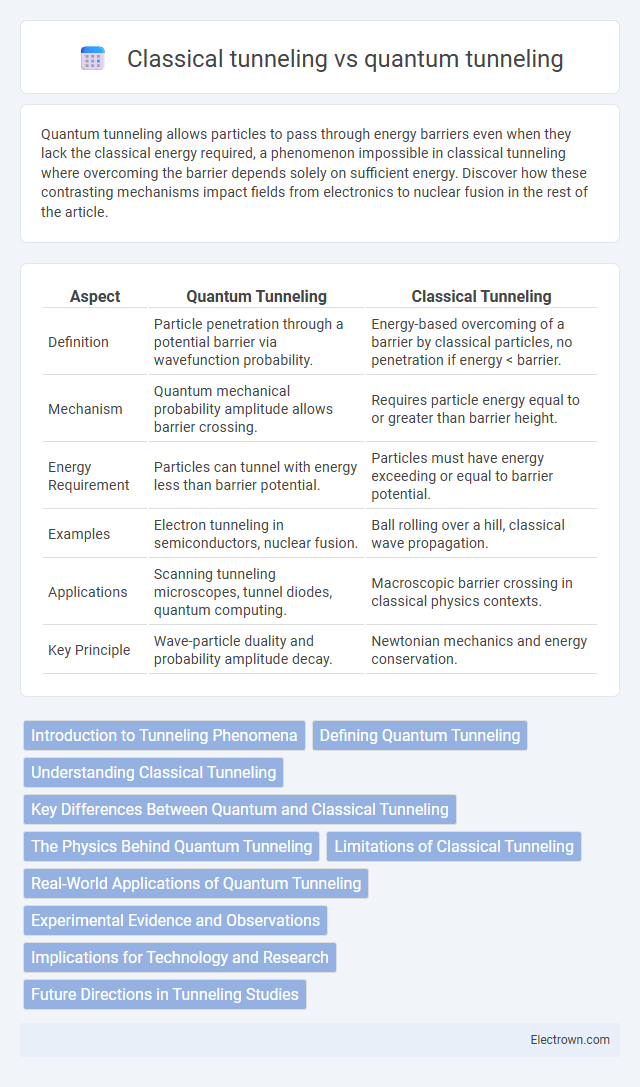Quantum tunneling allows particles to pass through energy barriers even when they lack the classical energy required, a phenomenon impossible in classical tunneling where overcoming the barrier depends solely on sufficient energy. Discover how these contrasting mechanisms impact fields from electronics to nuclear fusion in the rest of the article.
Table of Comparison
| Aspect | Quantum Tunneling | Classical Tunneling |
|---|---|---|
| Definition | Particle penetration through a potential barrier via wavefunction probability. | Energy-based overcoming of a barrier by classical particles, no penetration if energy < barrier. |
| Mechanism | Quantum mechanical probability amplitude allows barrier crossing. | Requires particle energy equal to or greater than barrier height. |
| Energy Requirement | Particles can tunnel with energy less than barrier potential. | Particles must have energy exceeding or equal to barrier potential. |
| Examples | Electron tunneling in semiconductors, nuclear fusion. | Ball rolling over a hill, classical wave propagation. |
| Applications | Scanning tunneling microscopes, tunnel diodes, quantum computing. | Macroscopic barrier crossing in classical physics contexts. |
| Key Principle | Wave-particle duality and probability amplitude decay. | Newtonian mechanics and energy conservation. |
Introduction to Tunneling Phenomena
Tunneling phenomena describe particles passing through energy barriers that appear insurmountable in classical physics, highlighting a fundamental difference between classical and quantum mechanics. Classical tunneling is impossible because particles lack the energy to overcome barriers, whereas quantum tunneling arises from wave-particle duality and probabilistic behavior, allowing particles to probabilistically appear on the other side of barriers. Your understanding of these concepts is essential for applications in semiconductor physics, nuclear fusion, and quantum computing.
Defining Quantum Tunneling
Quantum tunneling occurs when particles pass through energy barriers that would be insurmountable according to classical physics, leveraging the probabilistic nature of quantum mechanics. Unlike classical tunneling, which typically refers to physical penetration in macroscopic systems, quantum tunneling exploits wave-particle duality allowing electrons, atoms, or molecules to "tunnel" through potential barriers without the required energy. Your understanding of quantum tunneling reveals how phenomena such as nuclear fusion in stars and modern electronic devices like tunnel diodes operate beyond classical explanations.
Understanding Classical Tunneling
Classical tunneling refers to the phenomenon where particles pass through a barrier by overcoming the barrier's potential energy, requiring sufficient kinetic energy to surmount it. Unlike quantum tunneling, which allows penetration through barriers without the necessary energy due to wavefunction probability, classical tunneling involves particles possessing energy equal to or greater than the barrier height. This concept is rooted in Newtonian mechanics and classical physics, where energy conservation dictates that particles must have the required energy to overcome physical obstacles.
Key Differences Between Quantum and Classical Tunneling
Quantum tunneling occurs when particles penetrate energy barriers despite lacking sufficient classical energy, enabled by wave-particle duality and probabilistic behavior in quantum mechanics. Classical tunneling, on the other hand, requires physical pathways or imperfections in barriers, as particles must have enough energy to overcome obstacles or find alternative routes. Understanding these key differences can help your comprehension of phenomena like nuclear fusion and semiconductor behavior in quantum devices.
The Physics Behind Quantum Tunneling
Quantum tunneling occurs when particles pass through energy barriers that are insurmountable according to classical physics, enabled by the probabilistic nature of wavefunctions described in quantum mechanics. The particle's wavefunction extends beyond the barrier, allowing a finite probability of transmission despite insufficient classical energy. Unlike classical tunneling, which is impossible due to strict energy conservation laws, quantum tunneling exploits the uncertainty principle and wave-particle duality to explain phenomena such as nuclear fusion and semiconductor operation.
Limitations of Classical Tunneling
Classical tunneling is constrained by energy barriers that particles cannot overcome without sufficient kinetic energy, making it impossible for particles to penetrate potential barriers higher than their energy level. This limitation restricts classical tunneling to scenarios where particles have enough energy to surmount barriers through thermal activation. Quantum tunneling, in contrast, exploits wave-particle duality, enabling particles to probabilistically pass through barriers even when classical energy requirements are not met.
Real-World Applications of Quantum Tunneling
Quantum tunneling enables technologies like flash memory and tunnel diodes by allowing particles to pass through energy barriers that classical physics forbids. Your smartphone's flash storage relies on tunneling effects for data retention, while scanning tunneling microscopes use quantum tunneling to image surfaces at the atomic level. These real-world applications demonstrate the critical role of quantum tunneling beyond traditional classical limitations.
Experimental Evidence and Observations
Quantum tunneling is experimentally observed through phenomena such as alpha decay, where particles penetrate potential barriers they cannot classically surmount, a behavior confirmed by precise measurements of decay rates. Classical tunneling lacks such empirical support, as classical physics predicts zero probability for barrier penetration, making quantum tunneling essential to explaining electron transport in tunnel diodes and scanning tunneling microscopy images. Your understanding of these effects can be enhanced by studies measuring conductance variations at atomic scales, providing direct evidence of quantum tunneling in action.
Implications for Technology and Research
Quantum tunneling allows particles to pass through energy barriers that classical physics deems impenetrable, enabling innovations in semiconductor devices such as tunnel diodes and quantum computers. Classical tunneling, limited to macroscopic phenomena like fluid flow through porous media, lacks the precision and speed offered by quantum effects. Your exploration of quantum tunneling can unlock advancements in nanoscale electronics, energy-efficient transistors, and novel sensors, driving cutting-edge research and transformative technological applications.
Future Directions in Tunneling Studies
Quantum tunneling research is rapidly advancing toward exploiting nanoscale materials and ultrafast measurement techniques to enhance device performance in quantum computing and energy applications. Classical tunneling studies continue to refine macroscopic models for barrier penetration in fields such as semiconductor physics and geophysics, integrating machine learning for predictive accuracy. Your understanding of tunneling mechanisms will benefit from emerging interdisciplinary approaches combining quantum theory, materials science, and advanced simulation platforms.
quantum tunneling vs classical tunneling Infographic

 electrown.com
electrown.com